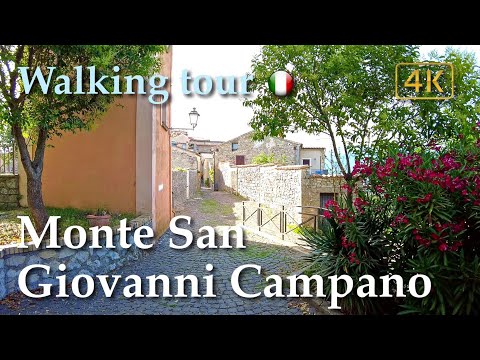Monte San Giovanni Campano, Italy【Walking Tour】With Captions - 4K

[Drone intro] [Walking tour begins / Ducal Castle and Piazzale Corte] [St.Margherita Church *closed*] [...walking around the castle walls...] [Largo Castello] [Via Corte] [☀️St.Thomas of Aquinas icon☀️] between 1244 and 1245 St. Thomas Aquinas was imprisoned there. Read history of the castle at the end of the video [...descending to Via San Luigi...] [Public library (former hospital)] 1/8 ☀️Brief History☀️ According to the local historian Ireneo Pio Valeriani, the town developed under the name of Castelforte on a saddle between the rocky hill on which the castle was built (late 10th century) and the San Marco hill, within the of the phenomenon of medieval fortification.
2/8 According to another local historian, Vincenzo Belli, the origin of the town dates back to the 5th century, due to the transfer of the inhabitants of the Roman city of Cereate, located a short distance to the north-west, to a safer place. 3/8 At the beginning of the 6th century a Benedictine monastery was built nearby, dedicated to Saints John the Baptist and the Evangelist, according to tradition founded by Saint Benedict of Norcia himself, who would have a temple of Janus located on the nearby Colianese was destroyed. 4/8 From the monastery derives the name subsequently taken from the locality of Monte San Giovanni, to which the adjective "Campano" was added due to the long belonging to the province of Campagna and Marittima of the Papal State. 5/8 In 1495 Charles VIII of France occupied the territory, destroying the castle and the following year, in 1496 the Duchy of Sora, while managing to defend the Liri valley from the siege of Prospero Colonna and Federico I of Naples, but lost Esperia and Monte San Giovanni Campano. 6/8 In 1867 it was the battlefield of the Agro Romano campaign for the liberation of Rome, the military campaign conducted by the volunteers of Giuseppe Garibaldi with the aim of conquering Rome.
7/8 In particular, it was the scene of a clash in which about 30 Garibaldian volunteers, barricaded inside the Valentini house, fought 400 papal soldiers for hours, finally managing to break the encirclement and rejoin the bulk of the troops. 8/8 After the plebiscite of 1870 the territories of the Papal State, and therefore also Monte San Giovanni Campano, became part of the Kingdom of Italy. [Piazza Marconi] 1/2 ☀️Church St.Maria della Valle☀️ Of medieval origin, it appears for the first time in an act of 1186. The current facade dates back to the 16th century. The church preserves the Grand Cross that is carried in processions. 2/2 The apse is of the 19th century, and there are paintings by Sarra, Balbi and the Cavalier d'Arpino school. A wooden statue of the Madonna del Suffragio from the Lucca school dates back to the 16th century. [Piazza Marconi] [Via Roma and inside old town] [Church of St.Maria dell'Arendola *closed*]
[...walking...] [My new Friend in San Giovanni Campano] [...walking...] [Church of St.Rocco *closed*] 1/2 ☀️Church of St.Peter☀️ The church belongs to the 11th century. It differs from the other other churches of the town for its Greek cross plan and an octagonal apse with a lantern on top.
2/2 It's impossible to determine the reasons for the adoption of such traits, more typical of the churches built in Rome during the 15th century. Restored by the Carthysian monks in 1729, it has a pavement made of brickwork and three altars [...climbing up...] [Via S.Maria Arenula]
[Eastern Gate] [Old clock and small park] [...climbing up...] 1/4 ☀️Castle of Monte San Giovanni Campano☀️ Dating back to the end of the 10th century, belonged to the Counts of Aquino and between 1244 and 1245 St. Thomas Aquinas was imprisoned there. 2/4 Due to its strategic position, it has played for centuries the function of defense of the southern borders of the Papal State. It was destroyed by the troops of Charles VIII in 1495 and suffered serious damage in the earthquakes of 1703 and 1915, which forced the three upper floors to be demolished. 3/4 Privately owned, it has been restored since 1990. It includes the ducal palace with the underground prisons and the rooms where St. Thomas was held prisoner, one of which was transformed into a chapel, a 12th century square-plan male tower and a tower pentagonal of the 13th century.
4/4 A Renaissance palace was added to the castle itself, which forms a separate building, with a fountain in front of the entrance.
2021-07-30 20:05


